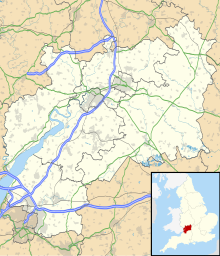geo.wikisort.org - Mountains
Leckhampton Hill and Charlton Kings Common (grid reference SO952187) is a 63.8-hectare (158-acre) biological and geological Site of Special Scientific Interest in Gloucestershire, notified in 1954.[1][2] There are five units of assessment.[3]
| Site of Special Scientific Interest | |
 Cliff face on Leckhampton Hill | |
 Location within Gloucestershire | |
| Location | Gloucestershire |
|---|---|
| Grid reference | SO952187 |
| Coordinates | 51.867306°N 2.070391°W |
| Interest | Biological/Geological |
| Area | 63.8hectare |
| Notification | 1954 |
| Natural England website | |
The site is listed in the 'Cotswold District' Local Plan 2001-2011 (on line) as a Key Wildlife Site (KWS).[4]
Location
The site is in the Cotswold Area of Outstanding Natural Beauty and is one of a series of unimproved Jurassic limestone grassland area which are located along the Cotswold scarp. It is south of Cheltenham and near the communities of Leckhampton and Charlton Kings, and has a north-facing aspect. The site also includes disused quarry faces, and quarry spoil which has been vegetated.[1]
Geology
The Leckhampton quarries expose the thickest single cross-section through the Middle Jurassic, Inferior Oolite strata of the area. They are a major research interest, and there are many published accounts of the last 150 years. Strata of some 60 m are exposed, and the large outcrops are of significant importance to those studying palaeontology or sedimentology, and for studying ancient environments generally.[1]
Biology
The site supports a range of habitats which include unimproved calcareous grassland, woodland and scrub, cliff faces and scree slopes. The grassland is of major importance and it comprises a tall ungrazed sward. This is dominated by tor-grass, upright brome, meadow oat-grass, sweet vernal-grass and quaking grass. It is noted for its range of herbs which include salad burnet, common rock-rose, common bird's-foot-trefoil. The quarry floors support wild thyme, dwarf thistle, yellow-wort and autumn gentian. The site supports many plants which are scarce at a national or county level. These include fly orchid, musk orchid and purple milk-vetch. It is one of a small number of sites which support meadow clary in the county.[1]
Shrub areas support nesting birds such as meadow pipit and grasshopper warbler. It is a shelter area for invertebrates and small mammals.[1]
There are wooded areas of broad-leaved and coniferous trees including mature beech. These areas support a woodland flora such as ivy broomrape, white helleborine and greater butterfly-orchid.[1]
There is a reported population of adder.[1]
References
- Natural England SSSI information on the citation
- Tewkesbury Borough Local Plan to 2011, adopted March 2006, Appendix 3 'Nature Conservation', Sites of Special Scientific Interest
- Natural England SSSI information on the Leckhampton Hill And Charlton Kings Common units
- Cotswold District Local Plan, Appendix 2, Key Wildlife Sites Archived 2013-10-13 at the Wayback Machine
SSSI Source
- Natural England SSSI information on the citation
- Natural England SSSI information on the Leckhampton Hill and Charlton Kings Common units
External links
- Natural England (SSSI information)
- View from Leckhampton Hill
- Paths on Leckhampton Hill
- Toposcope on Leckhampton Hill
- Cotswold Way on Leckhampton Hill
- Cliff faces on Leckhampton Hill
- Devil's Chimney, Leckhampton Hill
- Lower slopes of Charlton Kings Common
- Footpath on Charlton Kings Common
Другой контент может иметь иную лицензию. Перед использованием материалов сайта WikiSort.org внимательно изучите правила лицензирования конкретных элементов наполнения сайта.
WikiSort.org - проект по пересортировке и дополнению контента Википедии







